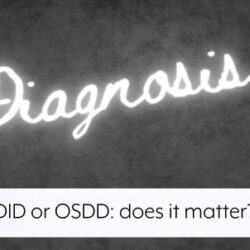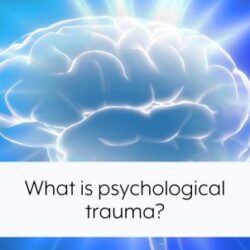
Dissociative disorder not otherwise specified is a strange-
How is DDNOS different to dissociative identity disorder?
The diagnostic criteria are given below, but on the whole DDNOS is the diagnosis of choice for partial dissociative identity disorder. The ISSTD Treatment Guidelines make a helpful distinction between two types of DDNOS: ‘not yet’ and ‘not quite’. Type 1a DDNOS is people who do in fact have dissociative identity disorder but have not yet been diagnosed. Type 1b DDNOS is people who do not quite meet the diagnostic criteria for DID — usually because they do not have amnesia between alters, or their alters/parts are not quite ‘separate’ enough to be classified as different identity states. DDNOS is actually the most common dissociative disorder and so there is some debate about whether it should be reformulated: as a ‘residual’ category it is meant to mop up a few cases that do not quite fit into other diagnostic boxes, not be a category all of its own!
Colin Ross (2007, p.142) says that: “The dividing line between dissociative identity disorder and most cases of Dissociative Disorder Not Otherwise Specified is arbitrary. Most cases of DDNOS are partial forms of DID which lack either clear switching of executive control, full amnesia barriers between identity states, or clear differentiation and structure of identity states. They are partial forms of DID with the same patterns of childhood trauma and co-
In summary, many people will be diagnosed with DDNOS because during the diagnostic process they fail to exhibit either amnesia between alters, or sufficiently elaborated alters. Many however may go on to be diagnosed with dissociative identity disorder at a later point, and many may actually have DID but there was not sufficient evidence for it during the brief diagnostic interview, based on the restrictive criteria specified by the DSM-
Symptomatic principles for dissociative disorder not otherwise specified
Diagnostic Criteria (Code 300.15) from DSM-
This category is included for disorders in which the predominant feature is a dissociative symptom (ie, a disruption in the usually integrated functions of consciousness, memory, identity, or perception of the environment) that does not meet the criteria for any specific Dissociative Disorder. Examples include:
- Clinical presentations similar to dissociative identity disorder that fail to meet full criteria for this disorder. Examples include presentations in which a) there are not two or more distinct personality states, or b) amnesia for important personal information does not occur.
- Derealization unaccompanied by depersonalization in adults.
- States of dissociation that occur in individuals who have been subjected to periods of prolonged and intense coercive persuasion (eg, brainwashing, thought reform, or indoctrination while captive).
- Dissociative trance disorder: single or episodic disturbances in the state of consciousness, identity, or memory that are indigenous to particular locations and cultures. Dissociative trance involves narrowing of awareness of immediate surroundings or stereotyped behaviours or movements that are experienced as being beyond one’s control. Possession trance involves replacement of the customary sense of personal identity by a new identity, attributed to the influence of a spirit, power, deity, or other person, and associated with stereotyped “involuntary” movements or amnesia and is perhaps the most common Dissociative Disorder in Asia. Examples include amok (Indonesia), bebainan (Indonesia), latah (Malaysia), pibloktoq (Arctic), ataque de nervios (Latin America), and possession (India). The dissociative or trance disorder is not a normal part of a broadly accepted collective cultural or religious practice.
- Loss of consciousness, stupor, or coma not attributable to a general medical condition.
- Ganser syndrome: the giving of approximate answers to questions (eg, “2 plus 2 equals 5”) when not associated with Dissociative Amnesia or Dissociative Fugue.


